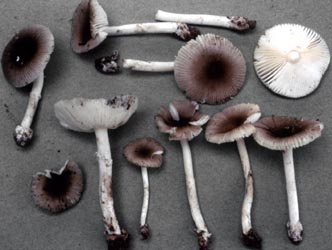|
[ Section Caesareae page. ]
[ Amanita Studies home. ]
[ Keys & Checklist/Picturebooks ] "Virginian Little Caesar"
BRIEF DESCRIPTION: Amanita virginiana is often so small that it can be found in good condition in lawns around mature oaks after the lawn has been mowed. Its 7 - 50 mm wide cap is dark brown at first and takes on grayer tones in expanding; its margin is striate from one-third to one-half of its radius and more pallid than its center. The gills are free or nearly so, rather close, white to off-white; and short gills are truncate to subtruncate. The bulbless stem is 8 - 76 x 2 - 7 mm with a small white volval sac (up to 14 mm high) at its base that some times looks like a small exploded piece of popcorn and with a fragile tiny annulus that is very often lost at maturity. The spores measure (9.1-) 11.5 - 15.0 (-20.5) x (6.5-) 8.5 - 11.2 (-15.5) Ám and are broadly ellipsoid to ellipsoid (rarely subglobose or elongate) and inamyloid. Clamps are common at bases of basidia. This is species is one of the small amanitas that has rather plentiful 2-spored basidia and spores that are quite large for the genus. Amanita pachysperma G. F. Atk. and A. subvirginiana (Murrill) Murrill appear to be closely related taxa. One should also compare A. ristichii Tulloss. Amanita virginiana is associated with oak (Quercus) in the eastern U.S.A. It is often plentiful locally, but apparently is seldom (knowingly) collected. -- R. E. Tulloss Photo: R. E. Tulloss (top, New Jersey); Richard Ballsley (center, northern New Jersey); Dr. L. R. Hesler (bottom, North Carolina, with permission of Dr. R. H. Petersen, L. R. Hesler Herbarium, Univ. of Tenn., Knoxville).
[ Section Caesareae page. ]
[ Amanita Studies home. ]
[ Keys & Checklist/Picturebooks ] Last changed 23 March 2009. |



